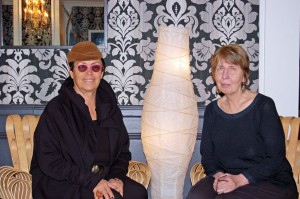
History is not something in the past, it’s something we are making today. In the contemporary art world and in our Southwest neighborhood, Mera Rubell is making history now. My recent interview with Mera was not a question and answer session, but rather a conversation in which Mera shared her ideas about how to make art, specifically cutting edge contemporary art, accessible to all.
Mera, who is well known in the art world as a collector, acknowledges how fortunate she is to be in a position to realize her life’s ambitions through the world of contemporary art, a life which “would never have complexity and challenges without meeting artists and engaging in the language of creativity.” This is the world she is excited to share and bring to the Southwest neighborhood, in a contemporary museum located at the old Randall School inside the Southwest community where co-operative development will bring new and dynamic ways to think about our world.
Since the Randall School on I Street SW was closed in 1978, it has been been a homeless shelter, studio space for artists, and the planned site for the Corcoran Gallery of Arts’ College of Art. The Rubells had already re-done the old Capitol Skyline Hotel, filling the lobby full of contemporary art and furniture, and now host an annual contemporary international art fair there each fall. After the Rubells acquired the school, they hired architect Bing Thom, the designer of the Arena Stage, to create the museum in the old school house as well as design co-located restaurants and apartments.
Mera’s plan for the core use of the Randall School is an intern program – probably three months long – in which Southwest teenagers could enroll. They would learn about art, but they would also experience what it is to talk about the range of emotions that is unspoken about that art. Docents at museums are usually unpaid, older, mostly retired people who are there to help and to explain the museum and its collections. Interns in most museum art training programs are art majors and graduate students. What Mera is offering is something totally different. The interns would be trained as art companions to visitors to the city who want to experience Washington’s incredibly rich collections. Their training would not be the conventional sort of pedantic instruction, rather they would be immersed in art experiences where they would be in dialogue with art works, exploring ways to look at it and converse about it. The experience they would provide for visitors would not be to give “just the facts,” but also for both to share what their feelings and thoughts are about the works. Also, the interns would be paid for this service.
In short, the interns would be “Culture Navigators” who would be knowledgeable in art. They would be up-to-date on what is the best tour route through the current multiple exhibits in the Washington area, exhibits which often have interesting connections to each other. They would engage in a dialogue about these works in which the visitor would be able to express their personal experience with the art they are viewing.
Mera explained that the idea behind the Culture Navigator was planted during her first teaching experience with Head Start in 1964. “I had no idea that it would lead to my own, together with my family’s, development of a public/private museum in the Wynwood area of Miami for the last 20 years. Our partnership with Miami’s public schools has given us access to exposing thousands of kids to the language of art. We have come to understand that art is a necessary and vital tool in the development of citizens for a democratic society. And above all, it’s a language that respects the emotional, cultural, sexual and creative identity of others.”
Engaging with a work of art is a power that transforms the activity of imagination. Art touches every area of our life. As a visual catalyst for communication, when ignited by a conversation between a viewer and a knowledgeable guide, it becomes a memorable and unique moment. The art intern program for Southwest youths to be “Culture Navigators” is the heart of the plan that includes local artist space, cutting edge exhibits from around the world, a theater for experimental videos, and talks with visiting artists. Admission to the collection would be free with a nominal charge for special exhibits. The Museum would be the heart of a re-invention of the community center as an expansive complex that would feature approximately 550 apartments (with 20% affordable), a culinary center, and cafes with outdoor seating.
What happens next is history!
Want to know more? Check out the Rubell Family Collection/Contemporary Arts Foundation web site: http://rfc.museum/
By Sheila Wickouski


